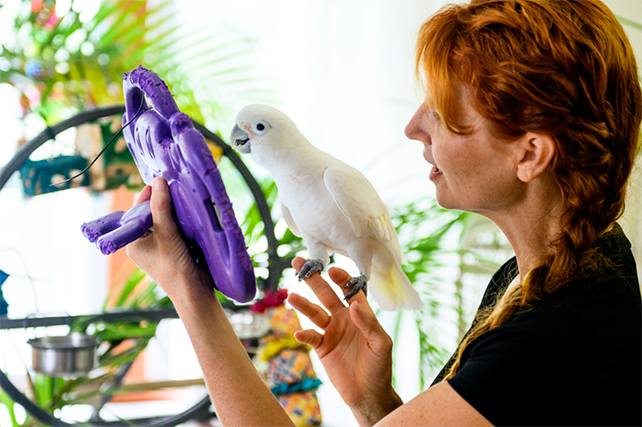Products You May Like
Parrots can get a lot out of video calls with their feathered friends just like we can from Zoom meetings with our favorite humans.
Findings from a recent study by researchers from Northeastern University and MIT Media Lab in the US and the University of Glasgow in the UK could point to ways to better look after the tens of millions of parrots around the world kept domestically as pets.
The research involved 15 parrots voluntarily initiating calls to a selection of other parrots on smart phones and tablets. The birds typically used as much calling time as they were allowed, and showed increased movement, preening, singing, and play while the calls were happening.
Friendships were formed too, with the birds showing strong preferences for which parrot to call when given a choice. The most popular parrots were also the ones that initiated the most calls, hinting at some level of social reciprocity.
“Video-calling technology helped a lot of people through the early days of the COVID pandemic where self-isolation was vital to slowing the spread of the virus,” says computer scientist Ilyena Hirskyj-Douglas from the University of Glasgow in the UK.
“There are 20 million parrots living in people’s homes in the US, and we wanted to explore whether those birds might benefit from video-calling too. If we gave them the opportunity to call other parrots, would they choose to do so, and would the experience benefit the parrots and their caregivers?”
Parrots are some of the smartest animals around, making them perfect for this study. As well as having vision that’s good enough to interpret movements on a screen in front of them, they happen to be very vocal.

In an initial two-week training period, the parrots were taught to ring a bell to prompt their caregiver to bring them a tablet for making a video call. The bell gave the birds a way to initiate a call voluntarily, which could last as long as five minutes or end sooner at any sign of stress, disengagement, or simply by leaving the space.
The parrot owners reported increased bonding with their pets too, and some parrots even formed attachments to the humans on the other end of the video call. The birds seemed to enjoy the extra attention they were getting from people as well as parrots.
Over the next two months, 147 calls were logged in a series of calls described by some of the owners as “transformative”.

“We saw some really encouraging results from the study,” says computer scientist Jennifer Cunha, from Northeastern University in Massachusetts. “The parrots seemed to grasp that they were truly engaging with other birds on screen and their behavior often mirrored what we would expect from real-life interactions between these types of birds.”
“We saw birds learn to forage for the first time, and one caregiver reported that their bird flew for the first time after making a call. All the participants in the study said they valued the experience, and would want to continue using the system with their parrots in the future.”
Parrots live in large flocks in the wild, but are obviously much more isolated when kept domestically – which isn’t helped by various transmissible diseases that makes it unsafe for parrot owners to meet up locally with their birds.
Isolation and boredom can lead to psychological problems for parrots, which manifest in a variety of ways: they might chew the bars of their cages for example, or pluck their own feathers, or rock excessively on their perches.
The researchers say that they noticed the birds engaging in the same call-and-response activities that they would in the wild, suggesting that these video chats can help give them something they’re missing.
While the researchers advise against anyone trying this at home for the time being, without the training and necessary monitoring, there’s a lot of promise here based on some of the great stories that came out of the study.
One such story involves two elderly and rather sickly macaws, who formed a deep bond during their video calls. Prior to the study, the birds barely interacted with others of their kind. They would dance and sing together, and even call “Hi! Come here! Hello!” when their partner would move out of the video frame.
“It really speaks to how cognitively complex these birds are and how much ability they have to express themselves,” says Hirskyj-Douglas. “It was really beautiful, those two birds, for me.”
The research was presented at the 2023 ACM CHI Conference on Human Factors in Computing Systems and can be found online.
